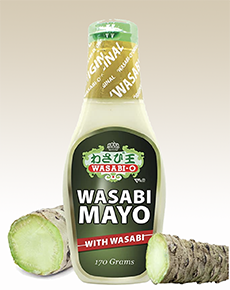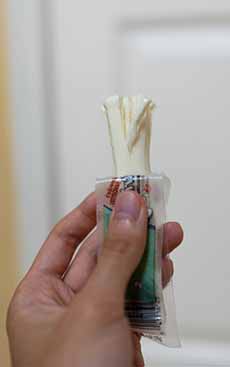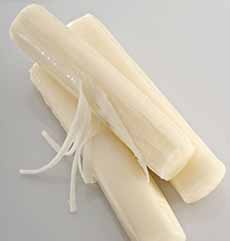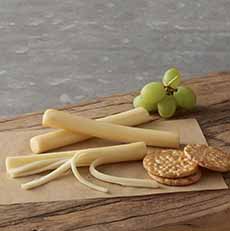String Cheese “Sushi” For National String Cheese Day
|
|
National String Cheese Day is September 20, 2022, and we’re having some food fun with this string cheese “sushi” recipe. Many people think of string cheese as a kid’s snack, or something to go into a lunchbox. At home, you can make everything from Halloween “broomsticks,” string cheese snakes, and flower bouquets to recipes we’d serve to a group of grown-ups. After years of snacking on string cheese right out of the package, who knew that we would uncover a cache of creative recipes from Frigo. Check them out. In the U.S., string cheese is typically a snack for kids. Frigo Cheese, a leading producer, has a dedicated site just for them, called Frigo Cheeseheads. Frigo makes three varieties of string cheese: original (mozzarella), Cheddar and mozzarella swirl, and a Colby and Monterey Jack blend. (Note that only mozzarella sticks are “stringable.” The others are cheese sticks, but not string cheese.) The recipe for string cheese sushi follows. > The history of string cheese is below. > The different types of cheese. > The history of cheese. First, a point of information: “Sushi” doesn’t mean raw fish; it is Japanese for vinegar[ed] (su) rice (shi). There’s no rice in this recipe; hence, “mock” sushi. But you could use the same ingredients, swapping out the bread for rice, to make “real” string cheese sushi. Either way, fill the roll with your favorite veggiess, thinly sliced. We tried different combinations from the following list. Our personal favorites: You can make it just by blending wasabi paste or powder into mayonnaise of plain yogurt to taste. If you don’t have wasabi, use a bit of hot sauce, cayenne, or red chile flakes. You can blanch the asterisked* vegetables if you like. 1. PLACE one slice of bread on a smooth surface. Roll the slice flat with a rolling pin and cut off the crusts. Spread the bread with a thin layer of cream cheese. 2. LAY the vegetables on top of the cream cheese. Experiment with what assortment of veggies makes the perfect roll for you. 3. TOP the vegetables with peeled strings of string cheese. 4. CAREFULLY ROLL up the bread until the ends meet (use a bit more cream cheese to seal the ends, if needed). Using a serrated knife, gently cut into pieces; plate and serve. String cheese is made in the U.S., Mexico, and some countries in Europe. It is a subcategory of the family of cheeses known as pasta filata†. That’s Italian for “spun paste,” referring to how the curds are heated and stretched/kneaded, or “spun.” The group is also known in English as stretched-curd, pulled-curd, and plastic-curd cheeses. Stretched curd cheeses manufactured with the pasta filata technique undergo a kneading of the fresh curd in hot water, which gives the cheese its fibrous, stringy structure. The string cheese subgroup includes string cheese from the U.S.; chechil from Armenia; dil peyniri from Turkey; korbáčik, a braided cheese from Slovakia (photo #10 is similar); and oaxaca from Mexico, among others. Recipes (including aging time) and shapes vary. You can typically peel the curd from the main body of the cheese—just try it with a ball of mozzarella. The curds of string cheese, a slightly drier (low moisture) mozzarella, are even more pliable. If you’ve never done it, pulling thin strings of cheese off the body is fun. In the U.S., string cheese refers to snack-sized, individually wrapped cylindrical “cheese sticks.” To make mozzarella, the cheese curds are heated to create a cohesive mass. The heat causes the casein proteins in the milk to align such that mozzarella is stretchy and elastic. To make string cheese, the cheese is stretched further. This completely aligns the proteins and allows the cheese to be pulled apart, string by string. Kids have fun peeling the cheese and eating the strings (photo #8), and adults can use the strings as a garnish (photo #7). American string cheese was invented by Wisconsin cheesemaker Francis Baker of Baker Cheese in 1976. His family’s cheese factory focused on mozzarella. Post World War II, American soldiers returning home from Italy had a hankering for pizza. The crust and the tomato sauce were easy enough to acquire, but mozzarella was difficult to find. In Italy, mozzarella was (and is) made from water buffalo’s milk‡. Italian immigrants to the U.S. substituted cow’s milk. It worked, and abetted the growth of the chain pizza business that was popping up throughout the Midwest: Pizza Hut (Kansas, 1958), Little Caesar’s (Michigan, 1959) and Domino’s (Michigan, 1960) [source]. Baker Cheese spotted the shift and turned its attention from Cheddar, then the company’s mainstay since 1916, to a full mozzarella plant. Baker made six-pound loaves and 20-pound blocks of mozzarella that restaurants would cut and slice for their pizzas. There were one-pound packages in grocery stores. But the company began to get requests from mozzarella-loving consumers who wanted smaller units that they could eat as a snack. By the 1970s, Francis Baker, son of founder Frank, had an idea for a snack cheese. He took a ball of mozzarella, heated and stretched it into a rope, and cut it into small chunks, creating the Original Baker String Cheese. Following the success of Baker string cheese, other companies began to make plain and flavored varieties, including Borden, Frigo, Galbani, Horizon, Kraft, Organic Valley, and Sorrento. Retail chains like Aldi (Happy Farms), Kroger, Safeway (Lucerne), Target (Good & Gather) Trader Joe, Walmart, and Whole Foods (365) sell private-label versions. In 2003, in the midst of the low-carb craze, the Atkins and South Beach diets, were an added boon for string cheese, and introduced new consumers to the product. Baker Cheese became an industry leader in the innovation and design of string cheese manufacturing equipment, pioneering the extrusion process and individually wrapped packages of string cheese. In the process, the company has won awards at the most prestigious cheese contests: the United States Cheese Championships (Best String Cheese) and the World Championship Cheese Contest (Best Flavored String Cheese, for Jalapeño) [source]. A tip: Microwave your string cheese for 7 to 8 seconds for even more flavor and aroma. †Pasta filata cheeses from Italy include burata, mozzarella, provolone and scamorza, among others. Mediterranean pasta filata cheeses include halloumi from Cyprus. There are numerous others made in Europe and Latin America. A subgroup is a braided cheese, made from strips of the highly elastic cheese wound together in a braid. Armenia, Lebanon, Syria, Turkey, and many Latin American countries make braided cheeses. ‡Mozzarella di bufala is the water buffalo product, fior di latte (“flower of the milk”) mozzarella is made from cow’s milk |
|
|
CHECK OUT WHAT’S HAPPENING ON OUR HOME PAGE, THENIBBLE.COM.
|
||












